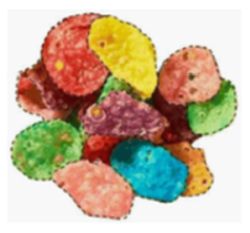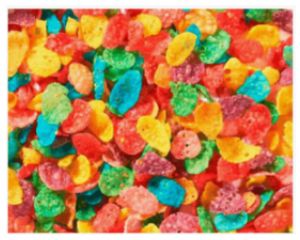In a precedential decision in January,1 the Trademark Trial and Appeal Board affirmed refusal of Post Foods LLC's application to register a color mark, consisting of "the colors of yellow, green, light blue, purple, orange, red and pink applied to the entire surface of crisp cereal pieces," depicted below, on the Principal Register for "breakfast cereals":

What Happened
Post originally sought registration of trade dress comprising both the seven colors and the shape of its Fruity Pebbles cereal, a timeless classic.
The examining attorney refused registration on the ground that the proposed trade dress failed to function as a mark because it consisted of a nondistinctive product design that is not registrable on the Principal Register without proof of acquired distinctiveness.
Although Post had submitted evidence to support its claim of acquired distinctiveness — including evidence of long use, extensive advertising, unsolicited media coverage and significant sales — the examining attorney found the evidence insufficient to demonstrate acquired distinctiveness. In response, Post submitted additional evidence of the mark's acquired distinctiveness, including a survey and consumer statements.
The examining attorney still found the evidence insufficient and maintained the nondistinctiveness refusal. In addition, the examining attorney required Post to disclaim rights in the cereal shape, on the ground that the cereal shape was nondistinctive and incapable of acquiring distinctiveness that would enable it to function as an indicator of source.
Post complied by amending the mark description to remove reference to the shape of the cereal. Left with only the claimed colors as the mark, and still unconvinced by Post's evidence of acquired distinctiveness, the examining attorney issued a final refusal.
Color, a type of trade dress, is registrable as a mark, but when used on a product itself — as opposed to product packaging — it is never inherently distinctive and can only be registered upon proof of acquired distinctiveness. The TTAB noted that Post's burden to prove that its color mark had acquired distinctiveness was substantial.
Reviewing the factual record, the TTAB found the examining attorney's evidence sufficient to establish that consumers encounter "numerous examples of multicolored breakfast cereals in a variety of shapes," which contradicted Post's claim that its use of the claimed colors was substantially exclusive.
The examining attorney's evidence included cereal boxes that showed similar multicolor combinations for cereals such as Cap'n Crunch's OOPS! All Berries, Froot Loops and Trix Fruity Shapes.
The evidence also included articles and recipes discussing rainbow-colored cereals, including a "Rainbow Fish" crusted-fish recipe incorporating rainbow-colored cereal, an ice cream parlor review noting that a store sells seasonal ice cream flavors like rainbow cereal, and an article discussing the use of food dyes in rainbow-hued cereal.
The TTAB discredited much of Post's evidence because the application identified the goods broadly as "breakfast cereals," rather than "crisp rice breakfast cereals," and Post could not claim exclusivity of its color mark among all breakfast cereals.
The TTAB also criticized Post's two surveys because they measured a much narrower mark, i.e., the claimed colors as applied to only one type of breakfast cereal, and not the actual mark, i.e., a color mark applied to all types of breakfast cereals.
While consumers might recognize Post's cereal's color, shape and texture combined as an indicator of source, the evidence was insufficient to show that consumers associate just the colors with Post alone "for any and all 'breakfast cereals."
Indeed, Post's survey itself showed that consumers correctly associated multicolored ring-shaped cereal with a different brand, demonstrating that consumers do not believe that all rainbow-colored cereals emanate from Post.
Accordingly, the TTAB concluded that Post had failed to show that multicolored cereal exclusively identified its Fruity Pebbles, and therefore affirmed the refusal to register Post's purported product trade dress.
Defining the Trademark, or Trade Dress
Brand owners should pay special attention to what exactly they are claiming as a trademark or trade dress.
A trademark can be a word, phrase, symbol or design, or a combination of these that identifies a product or service as emanating from a particular source and distinguishes it from others.
Trade dress, a type of trademark, protects the overall image and appearance of a product or its packaging, which may include size, shape, color, texture and graphics. Trade dress may take the form of product design, e.g., Converse shoes, or product packaging, e.g., the fluted Coca-Cola bottle or Tiffany blue.
In examining trademark applications, the examining attorney reviews the drawing of the mark, the written description of the mark and — for a use-based application — the specimen showing the mark as used in connection with the goods or services, to confirm that they match and that the claimed mark is clearly and accurately defined.
Here, Post originally sought registration of trade dress comprising both the seven colors and the shape of its cereal. The description of the mark as filed stated: "The mark consists of the product configuration of crisp cereal pieces in the colors of yellow, green, light blue, purple, orange, red and pink."
And the drawing submitted was a close-up photograph of Post's Fruity Pebbles:

The examining attorney rejected this initial drawing because it was not a three-dimensional drawing showing the mark in solid lines and unclaimed parts in broken lines, as required for trade dress applications.
Post eventually submitted a new drawing, the image depicted at the top of this article, which shows the outline of its cereal pieces in broken lines — indicating that the shape of the cereal pieces is not claimed as part of the mark. The examining attorney also required Post to amend the description of its mark to delete the original mention of product configuration, and Post complied.
Finally, in response to further insistence from the examining attorney that the shape of Post's cereal pieces was incapable of functioning as a mark, Post added a sentence to its mark description explicitly acknowledging that "the broken lines depicting the shape of the crisp cereal pieces indicate the placement of the mark on the crisp cereal pieces and are not part of the mark."
Meanwhile, the identification of goods in the application remained broadly defined as "breakfast cereals."
This combination of technicalities turned Post's application upside down. Post originally claimed that, among all breakfast cereals, the combination of shape, texture and color uniquely identified its Fruity Pebbles.
But after the examining attorney determined that the shape and texture were nondistinctive and could not be considered part of the mark, Post was left with only the colors to identify its product, within a market of "breakfast cereals" that could be any shape and texture.
Although Post attempted, on appeal, to cling to an interpretation that its mark included the colors as applied to crisp rice cereal pieces, the TTAB concluded that the broken lines in the drawing meant the shape of the pieces was not claimed, and the mark was just a color mark.
These technicalities proved to be detrimental to Post's evidence submitted in support of its application. Specifically, because the proposed mark was only a color mark, the TTAB expected to see evidence relating to the identified colors only, without regard to the shape of the cereal.
Much of Post's evidence related to both the color and shape of its cereal, and thus did not match Post's burden of proving that the proposed color mark had acquired distinctiveness.
As the TTAB stated: "Simply put, Applicant's extensive evidentiary showing relating to consumer recognition of its cereal's color, shape, and texture misses the mark."
Post's Survey Fails Bedrock Principles
As another result of the technical issues that tortured Post's application and mismatched evidence, Post's surveys did not help show that Post's proposed mark had acquired distinctiveness.
The two surveys measured a much narrower mark, the colors as applied to only one type of breakfast cereal, and not the actual mark, the colors as applied to all types of breakfast cereals.
Put another way, the surveys did not test whether consumers associated the claimed colors only with Fruity Pebbles when applied to the full scope of goods identified in the application, namely, breakfast cereal of any shape and texture. The first survey assessed whether respondents could identify plain crisp rice cereal pieces and Post's Fruity Pebbles-colored crisp rice cereal pieces.
The TTAB rejected this survey because it did not provide evidence that the claimed colors had acquired distinctiveness for all breakfast cereals, including other noncrisp rice cereals in other shapes.
The second survey also did not help because it included multicolored toroidal or "ring-like cereal pieces" as the control. Because the proposed mark claims rights to the colors applied to any breakfast cereal shape, including ring-like breakfast cereals, the ring-like cereal pieces were not a proper control.
Further, the results of the second survey actually undermined Post's claim of acquired distinctiveness because most respondents, 89.3%, correctly identified the multicolored, ring-shaped cereal pieces as a third-party cereal — think Froot Loops.
This survey showed that, when differently shaped cereals are involved — as required in view of Post's goods identification and the removal of product shape as an element of the mark — consumers do not associate a multicolor appearance with only a single source.
Food for Thought
The convoluted and ultimately unsuccessful saga of Fruity Pebbles underscores the importance of strategically considering the interplay among mark description, mark drawing and goods identification when seeking protection for trade dress.
Applicants should think critically about what aspects of their product's appearance actually serve to help consumers identify the source, and within what segment of the relevant market that identifying function is effective.
Carefully defining trade dress before filing an application can hopefully help applicants avoid a prosecution trajectory that repeatedly chisels away at the claimed mark until what remains is not unique enough in the identified market to acquire distinctiveness and function as a mark.
Footnote
1. In re Post Foods, LLC , Serial No. 88857834 (TTAB Jan. 4, 2024) (precedential)
Originally published by Law360
The content of this article is intended to provide a general guide to the subject matter. Specialist advice should be sought about your specific circumstances.

